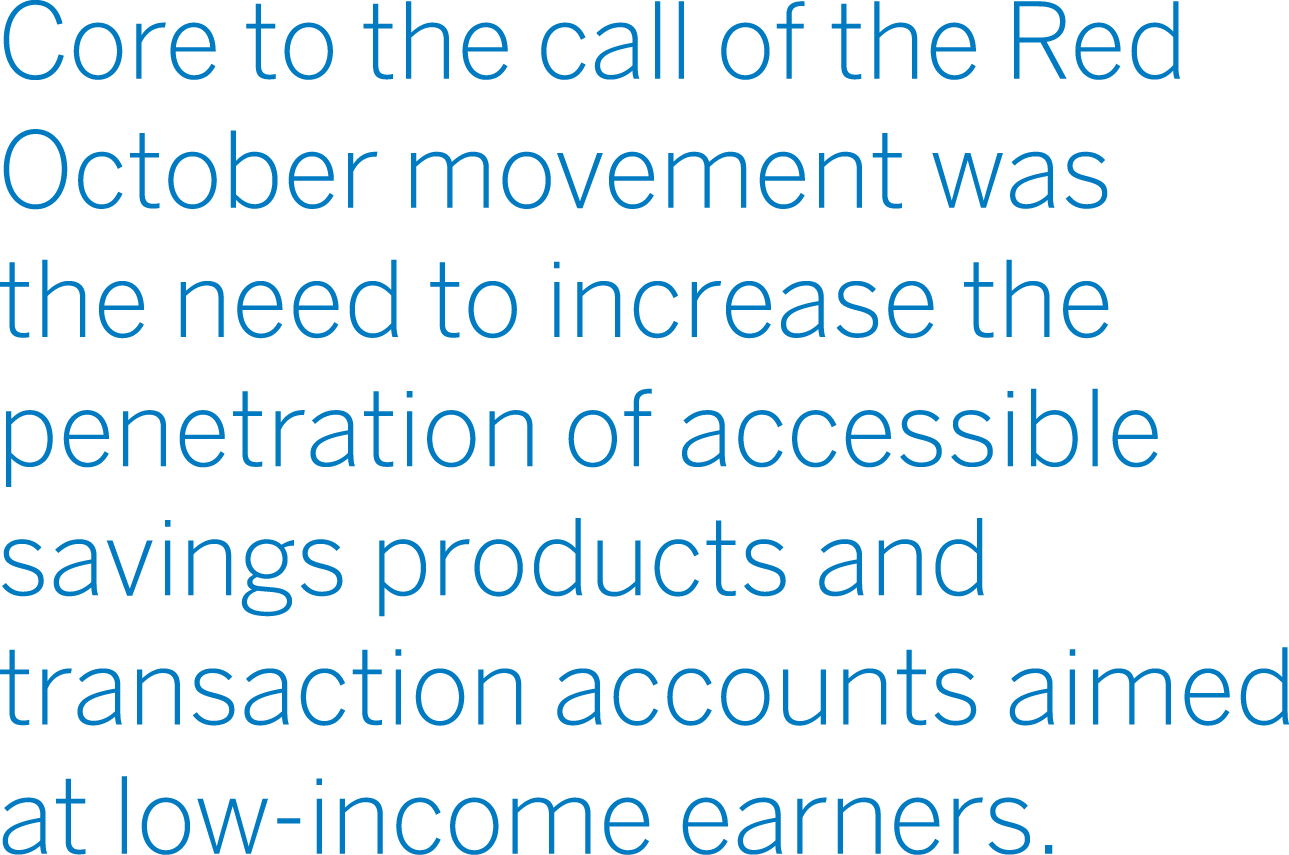red
october
revisited
read time 6min

education

ust over 20 years ago, the South African financial ecosystem was jolted into action by the Red October campaign, championed by labour unions. The purpose of the Red October movement was to advocate for improved financial access and inclusion. Historical patterns of economic marginalisation and exclusion had inevitably resulted in a financial ecosystem that some citizens found elusive in access pathways and complicated in product design.
Citizens on the lower end of the income scale were particularly affected by limited choices of suitable products. Part of the problem was that any product in the financial market comes with the costs of access, which the financial institutions have to pass on to their clients while also keeping the products profitable.
The tension point between the cost of access and affordability is captured by the simple example of the ratio of transaction fees relative to income. For a minimum wage earner, for example, transaction costs make up a significant portion of their income. For those who earn weekly wages, the need to transact generally matches the pay cycle, as weekly wages maintain weekly expenses rather than monthly expenses. Using a single week’s wages to pay for a month’s worth of groceries and transport is simply impossible. By the end of the month, the amounts spent on those transaction costs eat into a significant portion of a low-wage earner’s income.
The consequence of this dilemma was the incentivisation of less-than-desirable patterns where low-income earners and grant recipients would much rather withdraw their income all at once and keep it away from the formal financial system to avoid recurring transaction costs.
In addition to the dangers associated with keeping hard
currency, the same clients would then also lose out on the benefits associated with building steady profiles of income and spending patterns – factors that financial institutions consider when making decisions around lending.
A more complicated problem that was identified was the general lack of awareness around financial products and how to identify the most appropriate instruments for a particular set of circumstances. Consumers who did not have the sophistication of product assessment skills felt overwhelmed by the diversity of products on the market, and lacked the tools to understand each product well enough to make the call on which one was right for them.
MORE RESPONSIBLE SPENDING
The call of the Red October movement was for more inclusion and better education about the mechanics of the financial system, so that more citizens at the lower end of the income scale could be brought into the formal economy, and a more responsible culture of spending and saving could be promoted.
The importance of saving was linked to South Africa’s poor savings culture, and the reality that for low-income earners, income sources were more one-off than recurring. This meant that when emergencies arrived outside the “payment window”, there were no savings that could be redirected towards addressing the emergency. This created a new problem of reliance on informal credit markets, characterised by extortionate lending rates.
Core to the call of the Red October movement was the need to increase the penetration of accessible savings products and transaction accounts aimed at low-income


earners. In 2003, the usage patterns in the LSM 1-5 category were 32% for transaction accounts, 28% for bank savings products and just 5% for life insurance products. This represented a huge gap in the financial inclusion dimension that was intrinsically linked to the literacy dimension.
Given the tight correlations between a strong savings culture and a country’s investment culture, encouraging all sectors of society to save remains a critical instrument for promoting investment across the continent. Regrettably, the South African story indicates a regression in the savings rate over the past two decades. According to the Investec GIBS Savings Index, South Africa’s savings rate has been in decline despite the increase in income per capita since 1994.
MIXED RESULTS
The response to Red October’s call to action in 2000 was a commitment by South Africa’s financial system to invest in more accessible products and to sponsor more financial literacy initiatives. The Mzansi account, which was launched as a common product in a collaborative effort by the major retail banks, ensured a rapid acceleration in coverage in the period after 2002 when the banks, government and labour had committed to addressing the historical bottlenecks in access and inclusion at the Nedlac Summit.
While that momentum has been maintained and
many more South Africans now have access to the system, the literacy dimension continues to exhibit
mixed results. In 2015, the Human Sciences Research Council found that South Africa’s national financial literacy rate was “low to moderate” on average.
In an assessment conducted by the Organisation for Economic Co-operation and Development in 2021, only 42% of South Africa’s adult population was deemed financially literate. The lack of literacy was particularly – and unsurprisingly – more acute in rural areas and among low-income groups.
Pockets of excellence and coordinated efforts do exist in some industry and sector initiatives. The ASISA Foundation, for example, offers literacy programmes across the spectrum of financial sector areas, while the Banking Association South Africa’s StarSaver initiative targets high school students.
However, a gap persists in general and specialised financial literacy across the board. The consequence is an inability to harness the benefits of inclusion to promote a culture of good financial management and ultimately savings – both of which are so critical to getting South Africa and the continent on the pathway of leveraging savings as a springboard for investments.
Getting that balance right remains a core mission of the financial services industry.
INCLUSION, UNLOCKED
A 2022 Pan-African study by Vodafone Group, Vodacom Group, Safaricom and the UNDP found that while only 23% of adult Africans had access to a bank account in 2011, that figure had more than doubled to 55% by 2021.
In Africa, financial access is largely driven by digital access, says Doret Jooste, Head of Money Management & Advisory Enablement at Standard Bank. “We’ve seen a significant increase in financial access over the past decade or so,” she says. “Mobile wallets have given millions of Africans access to financial services as well as the ability to cost-effectively send and receive money without having a formal
bank account.”
Jooste adds that the development of mobile products and services – including mobile wallets and payments, funeral cover, and lower premium life insurance cover – has made it much easier for consumers to access those financial products and services. “And through regulatory financial education initiatives like Standard Bank’s #WalletWise, financial services companies now also offer financial literacy to help empower consumers to make more informed financial decisions,” she says.
TEXT: Khaya Sithole

ust over 20 years ago, the South African financial ecosystem was jolted into action by the Red October campaign, championed by labour unions. The purpose of the Red October movement was to advocate for improved financial access and inclusion. Historical patterns of economic marginalisation and exclusion had inevitably resulted in a financial ecosystem that some citizens found elusive in access pathways and complicated in product design.
Citizens on the lower end of the income scale were particularly affected by limited choices of suitable products. Part of the problem was that any product in the financial market comes with the costs of access, which the financial institutions have to pass on to their clients while also keeping the products profitable.
The tension point between the cost of access and affordability is captured by the simple example of the ratio of transaction fees relative to income. For a minimum wage earner, for example, transaction costs make up a significant portion of their income. For those who earn weekly wages, the need to transact generally matches the pay cycle, as weekly wages maintain weekly expenses rather than monthly expenses. Using a single week’s wages to pay for a month’s worth of groceries and transport is simply impossible. By the end of the month, the amounts spent on those transaction costs eat into a significant portion of a low-wage earner’s income.
The consequence of this dilemma was the incentivisation of less-than-desirable patterns where low-income earners and grant recipients would much rather withdraw their income all at once and keep it away from the formal financial system to avoid recurring transaction costs.
In addition to the dangers associated with keeping
hard currency, the same clients would then also lose out on the benefits associated with building steady profiles of income and spending patterns – factors that financial institutions consider when making decisions around lending.
A more complicated problem that was identified was the general lack of awareness around financial products and how to identify the most appropriate instruments for a particular set of circumstances. Consumers who did not have the sophistication of product assessment skills felt overwhelmed by the diversity of products on the market, and lacked the tools to understand each product well enough to make the call on which one was right for them.
MORE RESPONSIBLE SPENDING
The call of the Red October movement was for more inclusion and better education about the mechanics of the financial system, so that more citizens at the lower end of the income scale could be brought into the formal economy, and a more responsible culture of spending and saving could be promoted.
The importance of saving was linked to South Africa’s poor savings culture, and the reality that for low-income earners, income sources were more one-off than recurring. This meant that when emergencies arrived outside the “payment window”, there were no savings that could be redirected towards addressing the emergency. This created a new problem of reliance on informal credit markets, characterised by extortionate lending rates.
Core to the call of the Red October movement was the need to increase the penetration of accessible savings products and transaction accounts aimed at low-income earners.


In 2003, the usage patterns in the LSM 1-5 category were 32% for transaction accounts, 28% for bank savings products and just 5% for life insurance products. This represented a huge gap in the financial inclusion dimension that was intrinsically linked to the literacy dimension.
Given the tight correlations between a strong savings culture and a country’s investment culture, encouraging all sectors of society to save remains a critical instrument for promoting investment across the continent. Regrettably, the South African story indicates a regression in the savings rate over the past two decades. According to the Investec GIBS Savings Index, South Africa’s savings rate has been in decline despite the increase in income per capita since 1994.
MIXED RESULTS
The response to Red October’s call to action in 2000 was a commitment by South Africa’s financial system to invest in more accessible products and to sponsor more financial literacy initiatives. The Mzansi account, which was launched as a common product in a collaborative effort by the major retail banks, ensured a rapid acceleration in coverage in the period after 2002 when the banks, government and labour had committed to addressing the historical bottlenecks in access and inclusion at the Nedlac Summit.
While that momentum has been maintained and many more South Africans now have access to the system, the literacy dimension continues to exhibit mixed results. In 2015, the Human Sciences Research Council found that South Africa’s national financial literacy rate was “low to moderate” on average.
In an assessment conducted by the Organisation for Economic Co-operation and Development in 2021, only 42% of South Africa’s adult population was deemed financially literate. The lack of literacy was particularly – and unsurprisingly – more acute in rural areas and among low-income groups.
Pockets of excellence and coordinated efforts do exist in some industry and sector initiatives. The ASISA Foundation, for example, offers literacy programmes across the spectrum of financial sector areas, while the Banking Association South Africa’s StarSaver initiative targets high school students.
However, a gap persists in general and specialised financial literacy across the board. The consequence is an inability to harness the benefits of inclusion to promote a culture of good financial management and ultimately savings – both of which are so critical to getting South Africa and the continent on the pathway of leveraging savings as a springboard for investments.
Getting that balance right remains a core mission of the financial services industry.
TEXT: Khaya Sithole
ust over 20 years ago, the South African financial ecosystem was jolted into action by the Red October campaign, championed by labour unions. The purpose of the Red October movement was to advocate for improved financial access and inclusion. Historical patterns of economic marginalisation and exclusion had inevitably resulted in a financial ecosystem that some citizens found elusive in access pathways and complicated in product design.
A 2022 Pan-African study by Vodafone Group, Vodacom Group, Safaricom and the UNDP found that while only 23% of adult Africans had access to a bank account in 2011, that figure had more than doubled to 55% by 2021.
In Africa, financial access is largely driven by digital access, says Doret Jooste, Head of Money Management & Advisory Enablement at Standard Bank. “We’ve seen a significant increase in financial access over the past decade or so,” she says. “Mobile wallets have given millions of Africans access to financial services as well as the ability to cost-effectively send and receive money without having a formal bank account.”
Jooste adds that the development of mobile products and services – including mobile wallets and payments, funeral cover, and lower premium life insurance cover – has made it much easier for consumers to access those financial products and services. “And through regulatory financial education initiatives like Standard Bank’s #WalletWise, financial services companies now also offer financial literacy to help empower consumers to make more informed financial decisions,” she says.






